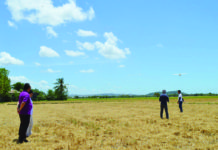ILOILO – The rabies vaccination coverage here reached 68.7 percent – equivalent to 173,672 dogs out of the 252,976 dog population – in 2018, according to the provincial government’s Office of the Provincial Veterinarian.
Last year’s figures were higher than the 2017 rabies vaccination coverage of 59 percent equivalent to 150,484 dogs (out of the 251,481 dog population that year).
Rabies is a fatal viral disease that primarily affects warm-blooded animals other than man, notably dogs, cats, rats, and bats, but which can be transmitted to humans by infected animals.
The rabies virus, which is present in the saliva of an infected animal, is passed to a human through a bite, or rarely, when the animal’s saliva gets in contact with a scratch or fresh break in the skin.
In the Philippines, dogs account for 98 percent of rabies infection, cats account for the remaining two percent, according to the Department of Health.
The Office of the Provincial Veterinarian’s rabies vaccination coverage target last year was 70 percent in each of Iloilo’s 42 towns and one component city.
The five municipalities with the highest rabies vaccination coverage were Badiangan (113.7 percent), Dumangas (101.9 percent), Mina (100.3 percent), San Rafael (96.7 percent), and Anilao (96.5 percent).
On the other hand, five municipalities with the lowest rabies vaccination coverage were the following:
* Alimodian (three percent or 150 dogs out of the 4,621 dog population)
* Batad (13.1 percent or 360 dogs out of the 2,745 dog population)
* Sara (21.1 percent or 645 dogs out of the 3,058 dog population)
* Leon (32.8 percent or 1,755 dogs out of the 5,352 dog population)
* San Joaquin (35.7 percent or 1,230 dogs out of 3,440 dog population
The dearth in livestock technicians tasked to vaccinate dogs was one of the factors in the low rabies vaccination coverage in these areas, said Dr. Darel Tabuada, veterinarian IV at the Office of the Provincial Veterinarian.
The provincial government actually deployed livestock technicians to some municipalities needing their services but the manpower was still not enough, said Tabuada.
Other towns, he added, had livestock technicians but these had other assignments such as on agricultural crops and fisheries.
In the town of Alimodian for example, said Tabuada, the livestock technician was busy overseeing programs for hinterland villages funded by the Korea International Cooperation Agency.
Rabies is a serious public health problem in the country. The Philippines is among the top 10 countries with the highest incidence of rabies in the world. Department of Health officials estimate that about 100,000 Filipinos are treated for dog bites and 200 to 300 die from rabies annually.
The rabies virus primarily affects the central nervous system. The early symptoms of rabies in people bitten by animals such as dogs are similar to those of many other infection — fever, headache, and general weakness or discomfort.
As the disease progresses, more specific symptoms appear and may include insomnia, anxiety, confusion, slight or partial paralysis, excitation, hallucinations, agitation, salivation, difficulty in swallowing, and hydrophobia (fear of water).
An infected dog can transmit the rabies virus even before it becomes ill, but it will invariably manifest signs and symptoms of rabies including change in behavior such as unprovoked aggressiveness and excitability, paralysis, and hydrophobia within five days, and die within two weeks, after it gets infected./PN



